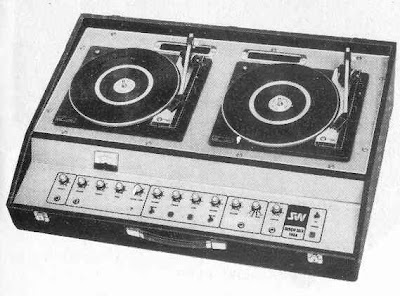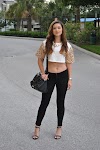A control panel or 'mixer' allows the DJ to fade the volume between the two turntables and to listen to tracks on headphones to find the correct starting point before playing 'live' to the audience (this is known as pre-fade listen or PFL for short). There is also provision for a microphone and auxiliary inputs for tape decks etc. Some consoles have built in amplifiers and others can be plugged into external ones.
The same basic features are used on modern DJ consoles using CD or MP3 players but they are much more compact in size and far more sophisticated.
Turntables are still used by some DJs particularly for 'scratching' which is a term used for moving the record backwards and forwards in time to the beat to create an effect.
 From 1977 this is an August MD1 disco unit with BSR turntables. All controls on the mixer are rotary, but sliders were used on some models by this time.
From 1977 this is an August MD1 disco unit with BSR turntables. All controls on the mixer are rotary, but sliders were used on some models by this time. This is a FAL Stereo console from around 1980 with Garrard 'Disco Driver 80' turntables (which were based on the SP25 model). Most people will have been to a mobile disco where the DJ had something made by FAL they were the disco equivalent of Dansette and were known for their reliability and low cost in the seventies and eighties. The letters stood for 'Futuristic Aids Ltd' -not a brand name you would use nowadays!!
This is a FAL Stereo console from around 1980 with Garrard 'Disco Driver 80' turntables (which were based on the SP25 model). Most people will have been to a mobile disco where the DJ had something made by FAL they were the disco equivalent of Dansette and were known for their reliability and low cost in the seventies and eighties. The letters stood for 'Futuristic Aids Ltd' -not a brand name you would use nowadays!! Citronic is a well respected name in professional audio and had a large range of products. This is an early 1980s Hawaii console with a rather nice wooden case. Once again Garrard turntables are fitted.
Citronic is a well respected name in professional audio and had a large range of products. This is an early 1980s Hawaii console with a rather nice wooden case. Once again Garrard turntables are fitted. Another well known manufacturer who is still with us is Cloud Electronics. This is their 'Windsor' console from the late 1980s with vari-speed turntables which were useful for synchronising the speed of two tracks so that they mixed together with no audible 'join' (depending on the skill of the DJ).
Another well known manufacturer who is still with us is Cloud Electronics. This is their 'Windsor' console from the late 1980s with vari-speed turntables which were useful for synchronising the speed of two tracks so that they mixed together with no audible 'join' (depending on the skill of the DJ). Another one from the mid seventies, this was manufactured by SW Amplification and again rotary controls are used.together with BSR decks.
Another one from the mid seventies, this was manufactured by SW Amplification and again rotary controls are used.together with BSR decks. Yet another seventies model, this August CSD5 was a top of the range model with a high spec mixer, built in lights and Garrard SP25 decks with magnetic cartridges.
Yet another seventies model, this August CSD5 was a top of the range model with a high spec mixer, built in lights and Garrard SP25 decks with magnetic cartridges.[Bedford Vintage Audio]




0 Yorumlar